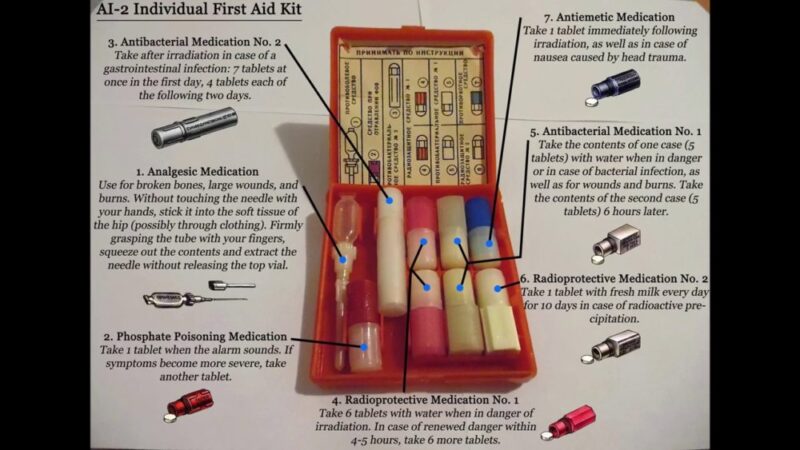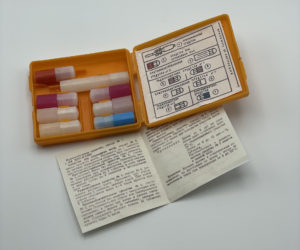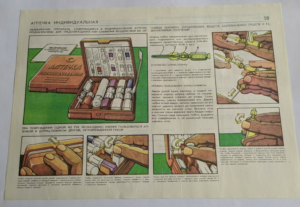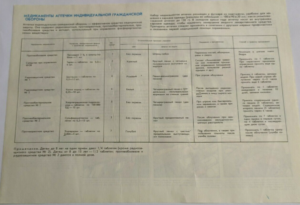
USSR Civil Defense CBRN Kits “Aptechka”
- Posted by Mike Shertz MD/18D
- Categories Tactical CBRN
🕖 Reading Time, 5 minutes
The AI-2 “aptechka” was an individual CBRN kit issued by the USSR for Civil Defense beginning in the late 1970s in a chemical, biological, radiological, or nuclear attack. Aptechka, (аптечка) loosely translated means first-aid kit. The Soviets prepositioned the kits in the populace’s hands with the plan for authorities to announce when to start using the medications. In concept, this is similar to the US National Strategic Stockpile, which claims they can distribute nerve agent antidotes to 90% of the US population in one hour.1 The Soviets used a very decentralized approach, whereas the US approach is much more centrally controlled.
The Soviet kit consisted of several prophylactic antibiotics, potassium iodine (in the event of radiation exposure), an anti-cholinergic medication for nerve agent poisonings, an anti-emetic for vomiting, and an injected pain medication. The kits varied. The “squeeze” syrette contained Promedol, a synthetic analgesic developed in the USSR in the 1950s. It is similar to morphine in addiction potential but causes less vomiting.2 Often, the kit instead contained Omnopone, a combination of morphine, codeine, and the exact narcotic seemed to change over the years as the kit was issued.
- Possibly a nerve agent “antidote” called athene may have been included. There is minimal mention of this potential nerve agent treatment in the Western medical literature. Other sources cite aprofen which does have anticholinergic effects and in early studies worked similar to atropine.3 Aprofen was also studied as a Soman nerve agent exposure pretreatment, similar to the current US doctrine of using pyridostigmine.4
- Sulfadimethoxine is a sulfa-based antibiotic still in use in the USA as a veterinarian antibiotic. It is long-acting and used once daily in animals. The kit’s included instructions directed taking seven pills at one time, followed by four pills once a day for two days for a GI illness that began after radiation exposure. (15 tbs). Presumably, they assumed if you received enough radiation to cause nausea and vomiting, your immune system/bone marrow was suppressed, and they were trying to prevent infection.
- Potassium iodine ((10 tabs). It is dosed once a day) was included to prevent uptake of radioactive iodine from a nuclear blast. “Dirty” bombs or radiological dispersion devices don’t generate radioiodine, and so there is no benefit to using it in those settings. Even after a nuclear detonation, potassium iodine only decreases your risk of thyroid cancer. It doesn’t protect the body in any other way.5
- Etaperazine, more commonly known in the west as Perphenazine, is an old-school antipsychotic medication. It is a phenothiazine derivative. It is felt to function via blockade of postsynaptic dopamine receptors in the brain. Perphenazines also have a strong anti-emetic effect at the emetic chemoreceptor trigger zone of the cerebellum.6 It was included in the kit as a medication to treat vomiting. The instructions stated to take one pill immediately after radiation exposure or nausea associated with a head injury.
- Chlortetracycline is a tetracycline antibiotic still used in veterinarian practice and in animal feed. Apparently, after 1987 it was replaced with Doxycycline.
- Cystamine is an organic disulfide felt in the 1960s to have a protective effect on diving cells after radiation exposure.7
Since each pill/medication container was different in size and color, the authorities would announce exactly which container to take based on the attack/exposure.
All details here are presented for historical reference only. The package inserts in these kits is in Russian and this article was created using sources that already translated the information. I can’t verify the accuracy of the translations.
Interested in more Tactical-Chem-Bio-Rad-Nuc?
- You might also check out the article on Why is CBRN Relevant Now
- A discussion of the Tokyo Nerve Agent MCI
- A discussion of the Russian agent Novichok
- Interesting statistics from our Tactical-CBRN By the Numbers
- And why the medical literature relies on certain species for CBRN testing
NOTES:
1Newmark J. Therapy for acute nerve agent poisoning: An update. Neurol Clin Pract. 2019 Aug;9(4):337-342.
2https://www.unodc.org/unodc/en/data-and-analysis/bulletin/bulletin_1957-01-01_3_page006.html2
3Dawson RM, Freeman SE, Paddle BM. Comparative effects of aprophen, atropine and benactyzine on central and peripheral cholinoceptors and on acetylcholinesterase. Biochem Pharmacol. 1985 May 1;34(9):1577-9.
4Leadbeater L, Inns RH, Rylands JM. Treatment of poisoning by soman. Fundam Appl Toxicol. 1985 Dec;5(6 Pt 2):S225-31.
5https://hps.org/publicinformation/ate/faqs/ki.html
6Bhargava KP, CHANDRA O. Anti-emetic activity of Phenothiazines in relation to their chemical structure. Br J Pharmacol Chemother. 1963 Dec;21(3):436-40.
7Kuna P. Farmakologické úcinky radioprotektivních látek cysteaminu, cystaminu a aminoetylisothiouronia [Pharmacological effects of radiation-protective agents cysteamine, cystamine, and aminoethylisothiuronium]. Cas Lek Cesk. 1969;108(13):404-12.
Dr. Mike Shertz is the Owner and Lead Instructor at Crisis Medicine. Dr. Shertz spent over 30 years gaining the experience and insight to create and provide his comprehensive, science-informed, training to better prepare everyday citizens, law enforcement, EMS, and the military to manage casualties and wounded in high-risk environments. Using a combination of current and historical events, Dr. Shertz’s lectures include relevant, illustrative photos, as well as hands-on demonstrations to demystify the how, why, when to use each emergency medical procedure you need to become a Force Multiplier for Good.






